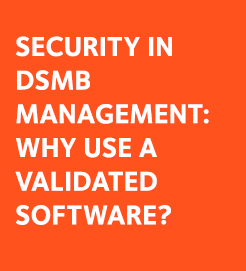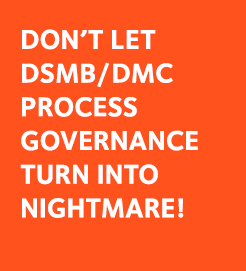We often think that adding and managing a DSMB to a clinical trial is a linear process with simple back-and-forth communication between the committee chairperson and the sponsor study team. But in real life things are always more complicated. Several parties are often involved such as CROs, independent statisticians or freelance medical experts. In this context communication becomes more complex and mistakes can and will be made. A robust software platform where management and communication rules are formalized and embedded can secure a flawless process and relieve the study team of one more cause of stress.
Let’s start with the simplest of questions: how many parties do you expect to be involved in the DSMB process of your clinical trial? If your answer is “two, me and the DSMB chairperson” then you don’t need to read the rest of this article. You may just as well pick up your phone, call the chairperson and start the negotiations. But if your answer is anything from “three” to “I don’t know” then you may want to consider the complex interactions that will unavoidably be created between these parties and start worrying about how to set them up and maintain them in such way as to ensure an easy management, a clear communication and an efficient and transparent process that will pass the “red face test” in font of any auditor.
Two themes impose themselves in this context: Manageability and Communication. Let’s discuss each one separately.
DSMB Manageability
Manageability is highly dependent on process compliance and traceability of events and follow-up actions. This means that numerous constraints that apply to the DSMB process must be harnessed, including but not limited to GCP compliance, adaptability to study timelines and members’ schedules. To this, one should add the low frequency of interactions, sometimes as low as once a year, that add stress to the study team as it requires to pick things up where you left them months ago, let alone the possibility that some members of the team may have changed and be totally new to the process. Keeping track of all the moving parts makes the DSMB dashboard look less like a Tesla car and more like a Space Shuttle. But the study team didn’t sign up for that. They need a simple, user-friendly interface with a robust back-end where rules and constraints are embedded, dates are remembered, actions are planned and tracked, and records are generated and archived. Only a well-thought software platform such as eDSMB® can do this kind of work.
DSMB Communication
Communication is the second point of attention. A DSMB process involves confidential information that could leak at a moment’s inattention and at the same time requires a flow of rich and complete data from the sponsor to the independent statistician and from there to the DSMB members to allow sound and timely decisions that can be explained and documented when the time comes. Trying to manage communication with manual rules-based processes is a recipe to disaster as it has been seen times and again. On the other hand, a software platform like eDSMB® will effortlessly control the flow of information, automatically applying the security rules regardless of the time since the last meeting or the identity of the persons involved provided that roles are assigned as needed.
In conclusion, two of the reasons for study team stress, manageability and communication, are far better controlled with a software than with manual processes, particularly in the case of DSMBs where rules are numerous and complex, timelines are long and confidentiality is a key factor. A dedicated platform such as eDSMB® can serve as a centralized hub for effective information flow and secure, timely communication among DSMB members and stakeholders.
DOWNLOAD NOW THE FREE DATA SAFETY MONITORING HANDBOOK
A single, integrated handbook regrouping various sources of information on when, why and how to set up and use DSMBs and DMCs.







